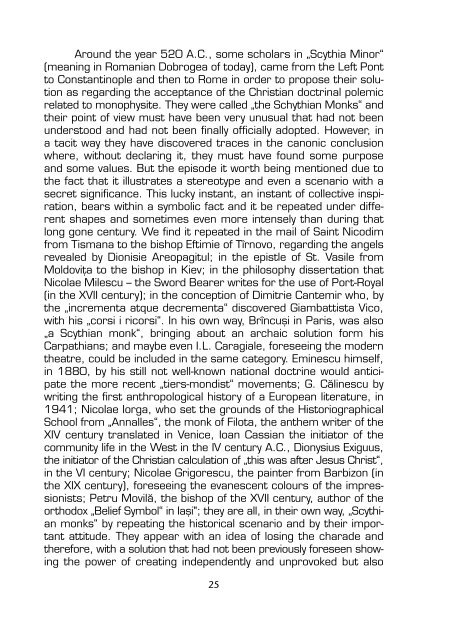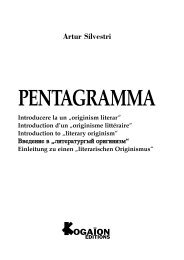genius loci pt. pdf.qxd - ROMANIAN LIBRARY
genius loci pt. pdf.qxd - ROMANIAN LIBRARY
genius loci pt. pdf.qxd - ROMANIAN LIBRARY
Create successful ePaper yourself
Turn your PDF publications into a flip-book with our unique Google optimized e-Paper software.
Around the year 520 A.C., some scholars in „Scythia Minor“<br />
(meaning in Romanian Dobrogea of today), came from the Left Pont<br />
to Constantinople and then to Rome in order to propose their solution<br />
as regarding the acce<strong>pt</strong>ance of the Christian doctrinal polemic<br />
related to monophysite. They were called „the Schythian Monks“ and<br />
their point of view must have been very unusual that had not been<br />
understood and had not been finally officially ado<strong>pt</strong>ed. However, in<br />
a tacit way they have discovered traces in the canonic conclusion<br />
where, without declaring it, they must have found some purpose<br />
and some values. But the episode it worth being mentioned due to<br />
the fact that it illustrates a stereotype and even a scenario with a<br />
secret significance. This lucky instant, an instant of collective inspiration,<br />
bears within a symbolic fact and it be repeated under different<br />
shapes and sometimes even more intensely than during that<br />
long gone century. We find it repeated in the mail of Saint Nicodim<br />
from Tismana to the bishop Eftimie of Tîrnovo, regarding the angels<br />
revealed by Dionisie Areopagitul; in the epistle of St. Vasile from<br />
Moldoviþa to the bishop in Kiev; in the philosophy dissertation that<br />
Nicolae Milescu — the Sword Bearer writes for the use of Port-Royal<br />
(in the XVII century); in the conce<strong>pt</strong>ion of Dimitrie Cantemir who, by<br />
the „incrementa atque decrementa“ discovered Giambattista Vico,<br />
with his „corsi i ricorsi“. In his own way, Brîncuºi in Paris, was also<br />
„a Scythian monk“, bringing about an archaic solution form his<br />
Carpathians; and maybe even I.L. Caragiale, foreseeing the modern<br />
theatre, could be included in the same category. Eminescu himself,<br />
in 1880, by his still not well-known national doctrine would anticipate<br />
the more recent „tiers-mondist“ movements; G. Cãlinescu by<br />
writing the first anthropological history of a European literature, in<br />
1941; Nicolae Iorga, who set the grounds of the Historiographical<br />
School from „Annalles“, the monk of Filota, the anthem writer of the<br />
XIV century translated in Venice, Ioan Cassian the initiator of the<br />
community life in the West in the IV century A.C., Dionysius Exiguus,<br />
the initiator of the Christian calculation of „this was after Jesus Christ“,<br />
in the VI century; Nicolae Grigorescu, the painter from Barbizon (in<br />
the XIX century), foreseeing the evanescent colours of the impressionists;<br />
Petru Movilã, the bishop of the XVII century, author of the<br />
orthodox „Belief Symbol“ in Iaºi"; they are all, in their own way, „Scythian<br />
monks“ by repeating the historical scenario and by their important<br />
attitude. They appear with an idea of losing the charade and<br />
therefore, with a solution that had not been previously foreseen showing<br />
the power of creating independently and unprovoked but also<br />
25



